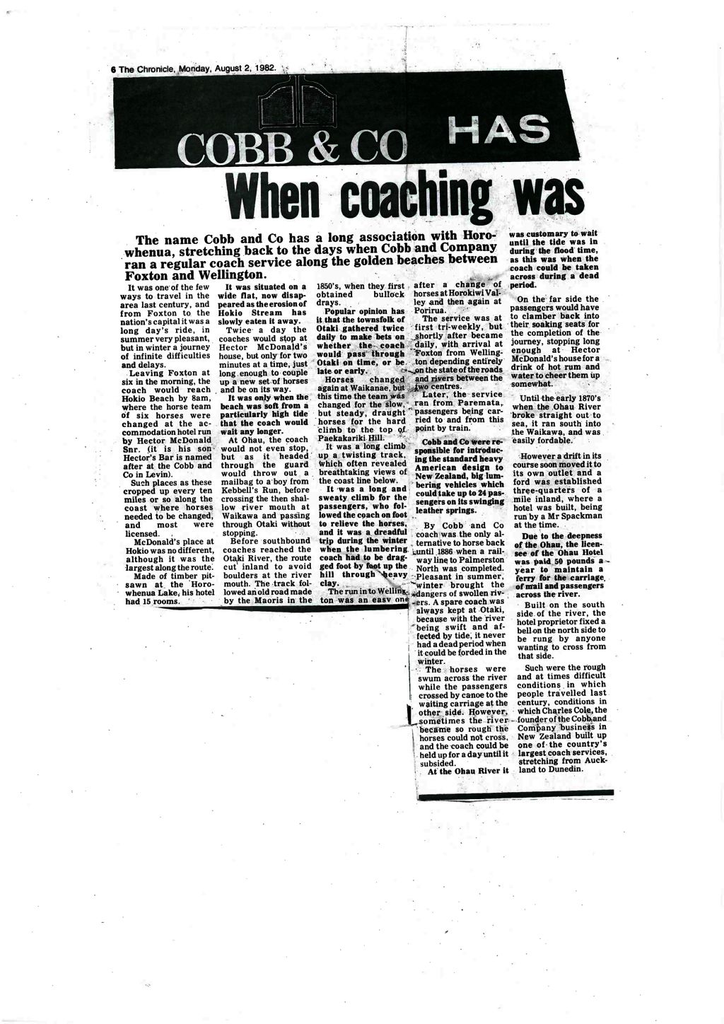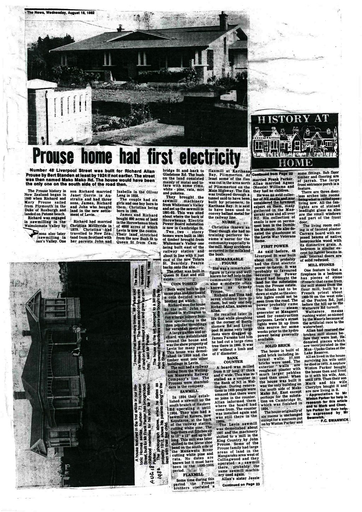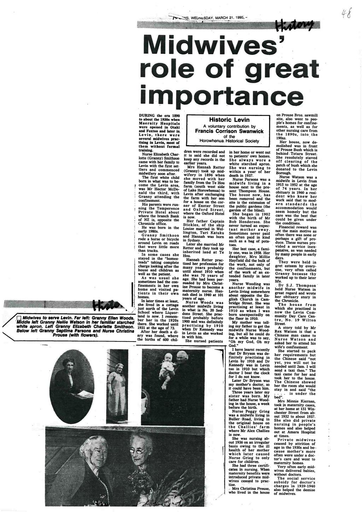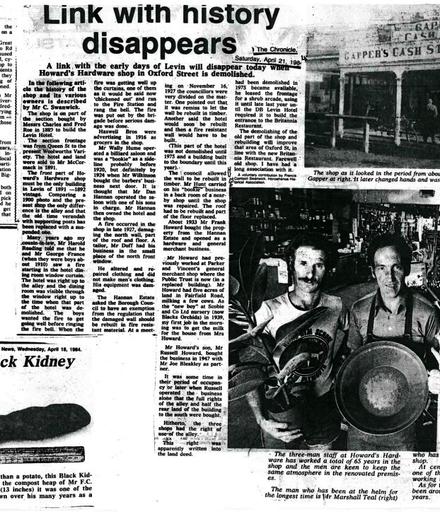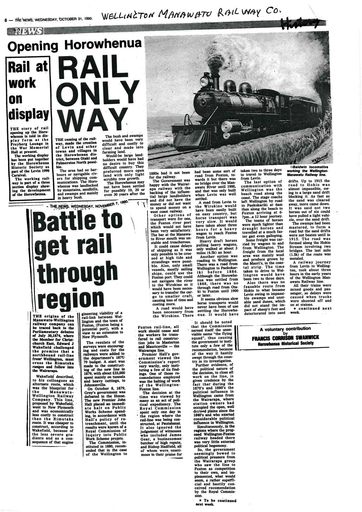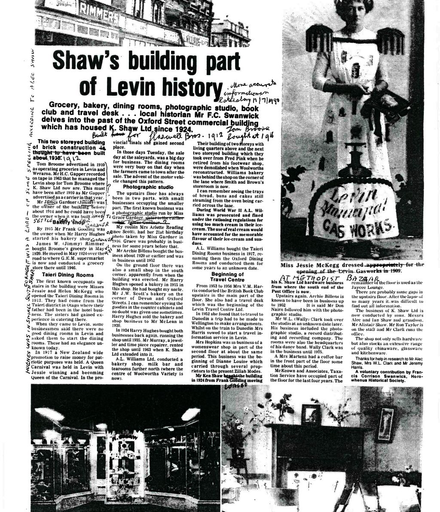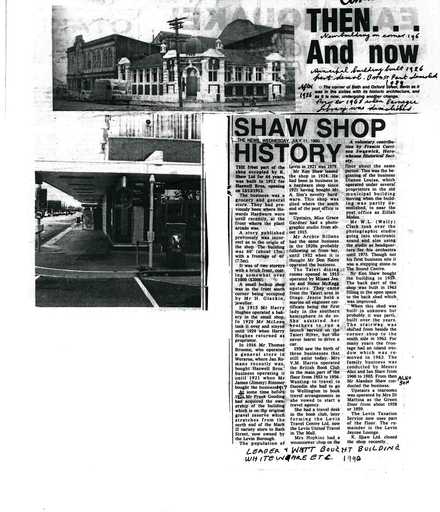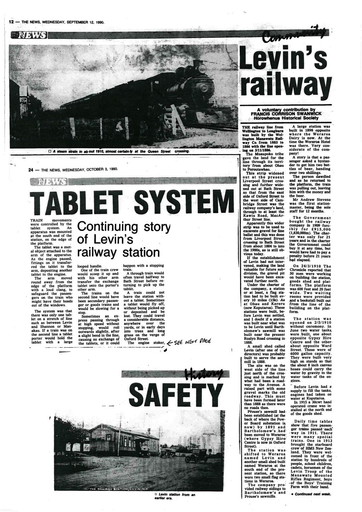It was one of the few ways to travel in the area last century, and from Foxton to the nation’s capital it was a long day’s ride, in summer very pleasant, but in winter a journey of infinite difficulties and delays.
Leaving Foxton at six in the morning, the coach would reach Hokio Beach by 8am, where the horse team of six horses were changed at the accommodation hotel run by Hector McDonald Snr. (it is his son Hector’s Bar is named after at the Cobb and Co in Levin).
 Photo at left: Passengers prepare to board one of the huge old coaches which lumbered up and down the beaches before the turn of the century. They could carry up to 24 people.
Photo at left: Passengers prepare to board one of the huge old coaches which lumbered up and down the beaches before the turn of the century. They could carry up to 24 people.
Such places as these cropped up every ten miles of so along the coast where horses needed to be changed and most were licensed.
McDonald’s place at Hokio was no different, although it was the largest along the route.
Made of timber pit-sawn at the Horowhenua Lake, his hotel had 15 rooms. It was situated on a wide flat, now disappeared as the erosion of Hokio Stream has slowly eaten it away.
Twice a day the coaches would stop at Hector McDonald’s house, but only for two minutes at a time, just long enough to couple up a new set of horses and be on its way.
 It was only when the beach was soft from a particularly high tide that the coach would wait any longer.
It was only when the beach was soft from a particularly high tide that the coach would wait any longer.
At Ohau, the coach would not even stop, but as it headed through the guard would throw out a mailbag to a boy from Kebbell’s Run, before crossing the then shallow river mouth at Waikawa, and passing through Otaki without stopping.
Before southbound coaches reached the Otaki River, the route cut inland to avoid boulders at the river mouth. The track followed an old road made by the Maoris in the 1850s, when they first obtained bullock drays.
Popular opinion has it that the townsfolk of Otaki gathered twice daily to make bets on whether the coach would pass through Otaki on time, or be late or early.
Horses changed again at Waikanae, but this time the team was changed for the slow but steady draught horses for the hard climb to the top of Paekakariki Hill.
It was a long climb up a twisting track, which often revealed breathtaking views of the coast line below.
It was a long and sweaty climb for the passengers, who followed the coach on foot to relieve the horses, and it was a dreadful trip during the winter when the lumbering coach had to be dragged foot by foot up the hill through heavy clay.
The run into Wellington was an easy one after a change of horses at Horokiwi Valley and then again at Porirua.
The service was at first tri-weekly, but shortly after became daily, with arrival at Foxton from Wellington depending entirely on the state of the roads and rivers between the two centres.
Later, the service ran from Paremata, passengers being carried to and from this point by train.
Cobb & Co were responsible for introducing the standard, heavy American design to New Zealand, big lumbering vehicles which could take up to 24 passengers on its swinging leather springs.
By Cobb & Co coach was the only alternative to horse back until 1886 when a railway line to Palmerston North was completed. Pleasant in summer, winter brought the dangers of swollen rivers. A spare coach was always kept at Otaki, because with the river being swift and affected by tide, it never had a dead period when it could be forded in the winter.
The horses were swum across the river while the passengers crossed by canoe to the waiting carriage at the other side. However, sometimes the river became so rough the horses could not cross, and the coach could be held up for a day until it subsided.
At the Ohau River it was customary to wait until the tide was in during the flood time, as this was when the coach could be taken across during a dead period.
On the far side the passengers would have to clamber back into their soaking seats for the completion of the journey, stopping long enough at Hector McDonald’s house for a drink of hot rum and water to cheer them up somewhat.
Until the early 1870s when the Ohau River broke straight out to sea, it ran south into the Waikawa, and was easily fordable.
However a drift in its course soon moved it to its own outlet and a ford was established three-quarters of a mile inland where a hotel was built, being run by a Mr Spackman at the time.
Due to the deepness of the Ohau, the licensee of the Ohau Hotel was paid 50 pounds a year to maintain a ferry for the carriage of mail and passengers across the river.
Built on the south side of the river, the hotel proprietor fixed a bell on the north side to be rung by anyone wanting to cross from that side.
Such were the rough and at times difficult conditions in which people travelled last century, conditions in which Charles Cole, the founder of the Cobb and Company business in New Zealand built up one of the country’s services, stretching from Auckland to Dunedin.
Early days of coaching
There may still be a few former travellers who can remember journeys made long ago in the fabled coaches of Cobb & Co which once swayed and jolted alarmingly over the rough roads of New Zealand.
Cobb & Co coaches had already been running for seven years in Australia when Charles Cole came from Victoria in 1861 with 50 horses and established in New Zealand a coaching business, for which he adopted the famous name.
Though not the first coaches in the country, they soon became through their efficient service, the most successful.
Cole guessed, much to the derision of locals, that he could run a coach from Dunedin to Gabriel’s Gully in nine hours more or less.
Cole set out from Dunedin on October 11 at 5.30am in 1861, driving the coach himself, made the camp as planned the same evening, and returned two days later.
Cobb & Co was in business and by 1867 there was a daily service from Auckland to Hamilton and in 1869 from Napier to Taupo.
His first coaches were the ‘Concord’ coach, with a roof and black duck curtains, the body rocking with a backwards – forwards motion, resting on straps of thick leather, rather than rigid metal springs.
Sundays Popular
There was little doubt that with the arrival of Cobb and Co, coach travel was catching on, and proved suspiciously popular on a Sunday.
Licensing laws of that period up until 1904, permitted the sale of intoxicating liquor to ‘bona fide travellers’ on a Sunday.
These were defined as persons who applied for refreshments at a hotel three miles from the place where they had lodged the night before.
Naturally the outlying hotels did a roaring trade on the Sabbath, and it was recorded that “any Newtonian who took who took his exercise in the direction of Kaiwharawhara or Ngauranga and their licensed houses could slake his thirst within the law.”
A poster advertising Cobb & Co’s coach run up the coast from Paremata to Foxton. Note the reference to the evening train from Foxton to Palmerston North and points north. The rail lines were torn up after World War 11 when all services ceased.
Photo caption:
A Cobb & Co coach crossing a shallow ford. Note the ladies travelling on top with their umbrellas up to shade them from the sun and dust.


